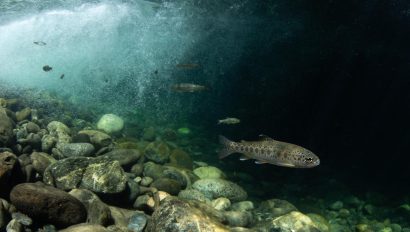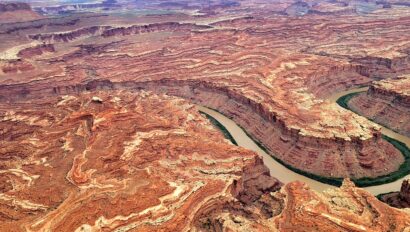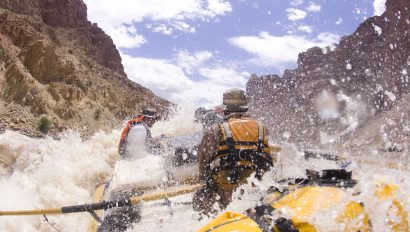Cataract Canyon: A Bright Spot in the Colorado River Basin
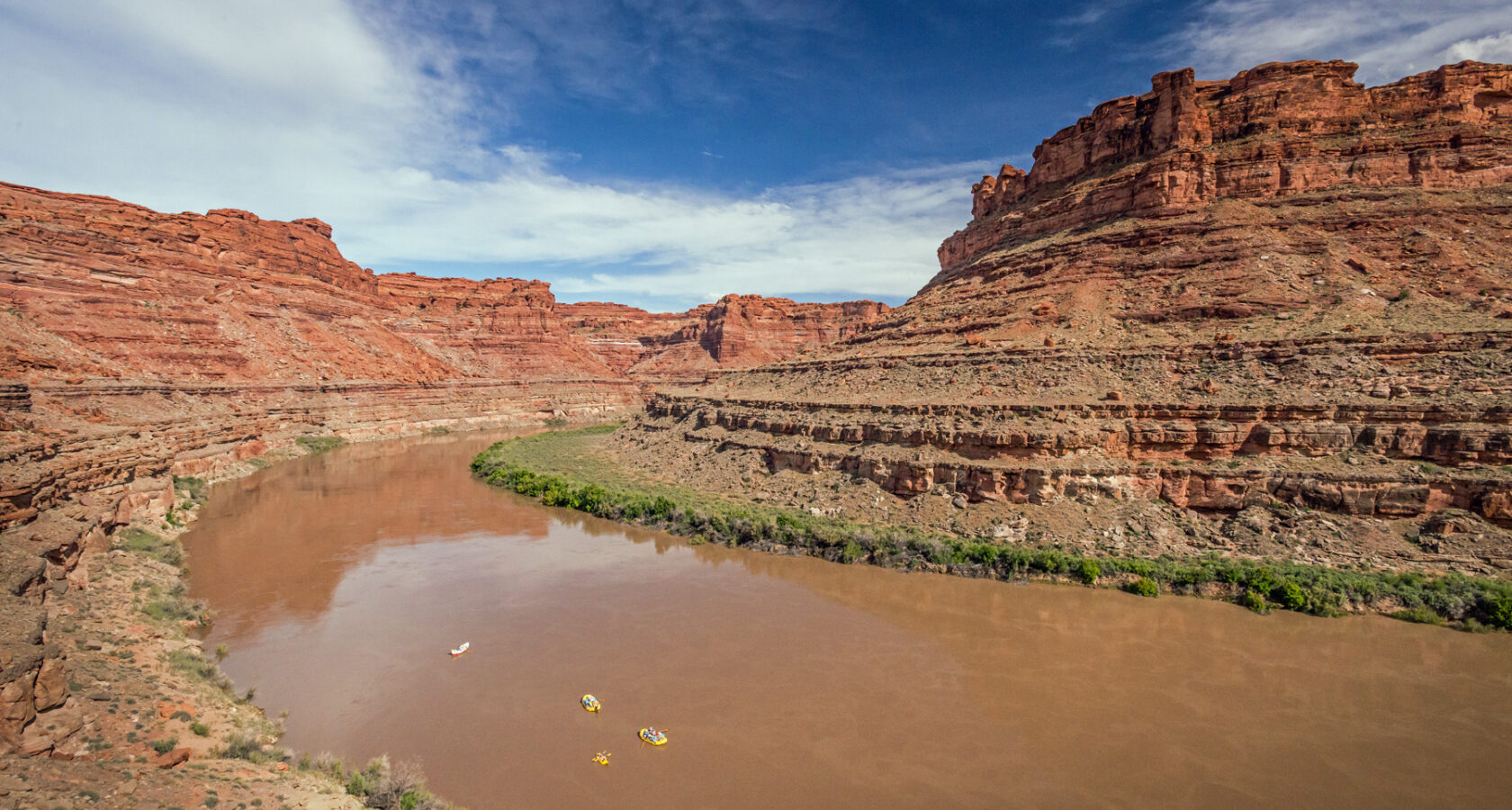

The Colorado River Basin is one of the most heavily-developed watersheds in the world, with fifteen dams on the mainstem Colorado and hundreds more on its tributaries, thirst-quenching tendrils reaching into the American West. But in this hard-working, exceedingly managed basin, one stretch of the Colorado flows defiantly and freely, reminding us exactly what this river is made of.
The Colorado through Cataract Canyon, carving through the fiery red sandstone of southern Utah before meeting the flatwater of Lake Powell, holds some of the largest, most sought after whitewater in the West. This stretch of the Colorado, relatively unimpeded by dams upstream, leaves its seasonal flows up to Mother Nature. And this year, as the hefty snowpack begins to melt in the mountains, river runners are in the midst of one of the most exciting high-water years in recent memory.
“It is something that I’ll think about in the middle of winter, when the snow is piling up,” says OARS Cataract Canyon guide, Pete Lefebvre. “It can be scary, and then when you get to camp and you’ve all made it through, it’s the highest high. It’s the most exhilarating feeling you can get. I remember a guide saying, ‘If I could just bottle this feeling up, I could sell this drink for a lot of money.’”
Lefebvre says the high elevation snow has just started to melt and the Colorado Basin River Forecast Center is currently forecasting a peak in the high 70,000 CFS range with the potential for flows to be even higher.
Cubic feet per second is how water managers (and excited guides) measure the volume and flow rate of water, equal to one cubic foot per second, which is equivalent to approximately 7.48 gallons per second or 448.8 gallons of water flowing per minute. At these flows, that’s essentially an Olympic swimming pool of water—88,235 cubic feet—rushing by you every second. Lefebvre says, “When Cat is flowing over 40,000 CFS, lake Powell is rising a foot a day.” And the Colorado is currently moving at about 52,000 CFS.
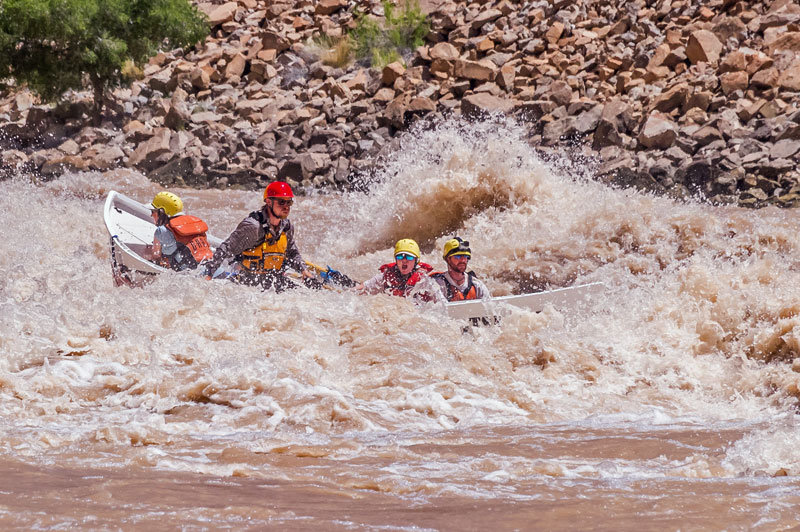
And the flows are likely to have staying power throughout the season. In a big year like this, we’re expecting elevated flows through July, and running trips well into September and October.
“September is this golden time. You’ve got lower flows that are still splashy and fun, big beaches, the bugs have gone home, and it’s starting to cool down,” says Lefebvre. In late summer, monsoons can come through delivering even more water, he says, “And that’s gorgeous too. It’s all part of the magic.”
So What Does it Feel Like to Raft the Colorado through Cataract at 70,000+ CFS?
“It’s a freight train. It’s so fast. There are no words. You see entire trees in the river,” says Lefebvre. “You’re on guard all the time. Explosive is the only word to describe it. I think that’s the only place I’ve ever had a wave crash and explode behind me.”
Lefebvre says the geology, the shape, and the location of Cataract, make this stretch deliver no matter what the flow. He adds that since humans have started recording peak flows—even during the highest flows ever recorded at 114,900 CFS in 1984—the rapids in Cataract never wash out.
Because of the free-flowing nature of the Colorado through Cataract, river runners see bigger fluctuations, higher highs and lower lows. But even in a low peak year, like 2022, which peaked at 28,000 CFS, Lefebvre says that’s still enough to get the adrenaline pumping and refresh the beaches and campsites.
“It’s like the Etch-A-Sketch, you know? It just kind of shakes it clean, starts over, and builds new beaches. So almost every year we get a reset. Fresh beaches and fresh sand. If it snows in the mountains, we’re going to have water moving through Cataract Canyon,” says Lefebvre.
It’s a different story downstream in Grand Canyon, which is heavily managed because of its location connecting the stretch of the Colorado between Glen Canyon and Hoover dams.
“All the stars have to align in a way for high flow to happen in Grand Canyon,” says Lefebvre.
And align they did. On April 24, dam operators opened bypass tubes to unleash a three-day pulse of high water from Glen Canyon Dam—roughly quadrupling the river’s flow to 39,500 CFS. Lefebvre’s wife and fellow OARS guide, Jamie Moulton, was in Grand Canyon recently and shared with him that the high-flow experiment did its job; refreshing and restoring beaches and campsites. He says, “It flushes out the canyon, it resets beaches and breathes new life into that more managed stretch of river.”
Eric Balken, the executive director of Glen Canyon Institute, says, “The Grand Canyon is starved of sediment. The ecosystem has been totally flipped upside down because of Glen Canyon Dam. And I think when we look at Cataract Canyon and the seasonal spring floods, the sediment flow and the nutrients that brings, it’s just a reminder of what a free-flowing river actually looks like.”
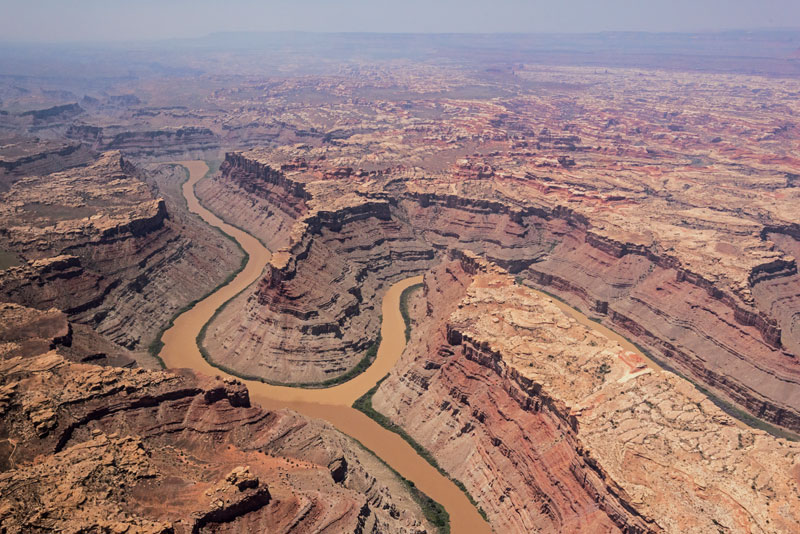
Why is This Stretch of the Colorado Still Wild and Free? That’s Largely Thanks to its Remoteness
Beginning at the Colorado’s confluence with the Green River, Cataract is a 46-mile-long canyon, carved into the sinuous curves of Canyonlands National Park and Glen Canyon National Recreation Area in southern Utah. The closest dam, the Grand Valley Diversion Dam in Palisade, Colorado, is more than 250 miles away, and while Flaming Gorge Dam on the Green controls some of that tributary’s flow, other major tributaries like the Yampa and White Rivers pump heavy spring flows into the Colorado below Flaming Gorge.
Beyond sheer volume and its free-flowing nature, the geography of the canyon serves up the perfect cocktail of constriction, gradient (between 10 and 16 feet per mile) and rocks to create its legendary, non-stop stretch of churning whitewater, boasting 29 rapids that keep guides like Lefebvre on their toes.
“Most of the canyon is flatwater, and then boom, you hit the whitewater and it’s whitewater for 15 miles,” says LeFebvre. And even when high flows smooth out the holes created by those rocks and the character of the canyon changes, the rapids morph into “giant constriction waves and breaking waves.”
All of these factors combined mean that the Colorado makes up its own mind, unbridled through this final stretch before hitting the slackwater of Lake Powell about 150 miles north of the Arizona border.
“We run some big water in Grand Canyon and you get a similar feeling, but this is even more, even higher. It’s hard to describe, you really have to experience it. It’s a very small club of people that guide and run Cataract when it’s really high water,” says Lefebvre.
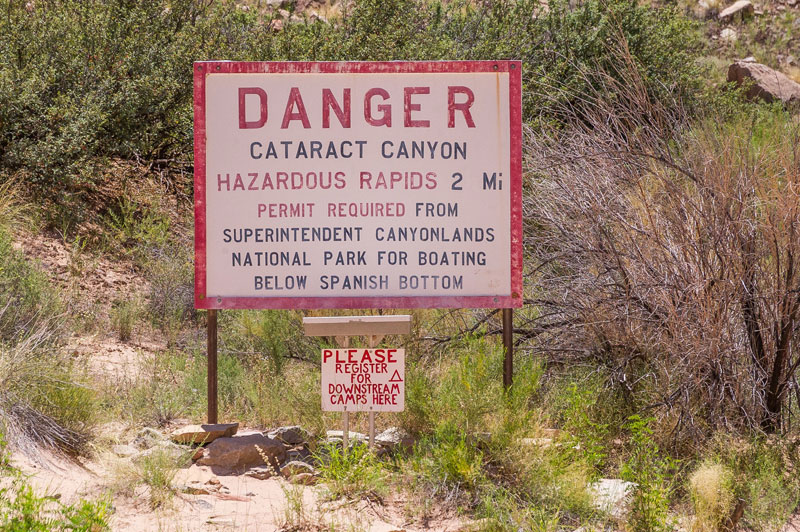
A Front Row Seat to the Action in Cataract—and a River Returning
For Lefebvre, his time in Cataract is about much more than the adrenaline rush. He says, “Every year I get more and more tied to that place.”
It’s that tie, that connection that sparked a deeper curiosity when he started working full time in Cataract Canyon in 2012. He says, “Every year, every trip, I noticed that the landscape was changing with the fluctuating lake levels. Not just the river, the whole environment down there.”
So he started taking photos and documenting those changes on every trip. Since then LeFebvre has joined with other Moab locals Mike DeHoff, Meg Flynn and Chris Benson to launch the Returning Rapids Project. The project aims to document the Colorado reclaiming lower Cataract Canyon and upper Glen Canyon as Lake Powell levels have dropped precipitously in recent decades because of overallocation combined with the climate-change fueled megadrought.
“As you float through the lower canyon, it’s the most beautiful part of the trip. It’s very Grand Canyon-esque with steep canyon walls and side canyons coming in,” says LeFebvre. “You get to the end of your trip and it’s like, well, what’s underneath this flatwater? What do these rapids look like? And you hear about Dark Canyon and Gypsum Rapid. They are these sleeping dragons underneath the flatwater in that lower canyon.”
And as the reservoir has receded—and with it, the flatwater, those sleeping dragons are waking up, revealing a river that is returning to its wild self, uncovering stretches of Glen Canyon that have returned to its original depths—and with it the rapids.
“Gypsum is the newest rapid coming back, and it was a big one. There’s a nice camp that’s come out there too,” says LeFebvre. “When you camp somewhere on the river, you get this intimate feel for that place as opposed to just floating by it. We get to sit there and witness this rapid that’s coming back.”
LeFebvre says it’s all about getting to spend that time, leaning into our innate curiosity, digging into the past and finding clues about what we might find in the future. He says it creates a certain level of excitement that for seasoned guides, “Sometimes if you run a rapid or stretch a river enough times, you kind of get desensitized to it, how beautiful it is, or how challenging a rapid can be. Cataract has become the exception. I just love that I get to share that excitement with the guests. We’re getting to tell this cool story about this place that was buried and is slowly coming back, slowly re-emerging.”
And Lefebvre says this year is going to be even more interesting. Before this spring, Lake Powell was at an all-time low, and now we’re barreling into a massive high-water season in Cataract. He says the river is likely to tear apart deposits in the “Dominy Formation” and push them further downstream into Glen Canyon. The massive mud deposit is named after Flloyd Dominy, the former commissioner of the Bureau of Reclamation and widely known as the architect behind Glen Canyon Dam. For 60 years, the equivalent of 61 supersize Mississippi River barge loads of sand and mud have been deposited there, on average, every single day. Those mud deposits, including Dominy’s namesake, are being revealed as well.
“So much of the conversation is about scarcity and curtailment and shortage and loss. It’s important to remember what we’re gaining,” says Balkan. “We’re gaining free-flowing rivers, we’re seeing native vegetation come back, we’re seeing wildlife habitat come back, we’re starting to see the glimpses of a national park coming back to life. In Glen Canyon and in this the main Colorado River there, we’re seeing rebirth. And it really is this incredible opportunity in my mind to rethink one of our country’s greatest environmental mistakes, which was damming Glen Canyon.”
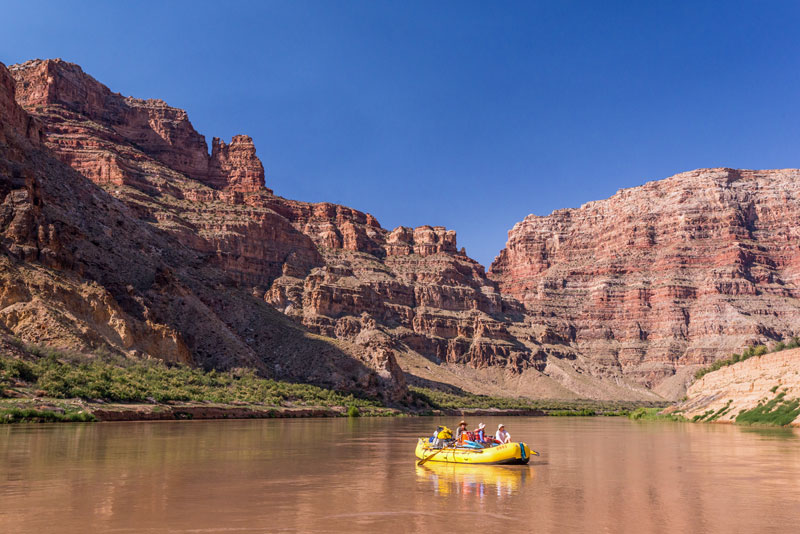
A Bright Spot in the Colorado Basin
Both Lefebvre and Balkan agree that what’s happening in Cataract Canyon is a bright spot in the Colorado Basin. It’s giving people the opportunity to witness the good news, to what happens when we allow rivers to act more like rivers, and think of the whole system as a living entity that we’re all tied to.
“When you spend time with people on the river, you end up talking about what’s going on. There might be people in your boat that are educated on the issues and some that you get to witness have that aha moment, when you see the spark of connection to this river, to this water, and to the other people on your trip,” says Lefebvre. “It’s a process of simply opening people’s eyes up to the different connections, the natural connections that when you live in a house and go to work every day, you don’t necessarily think about how this natural system’s all tied together and how these lives are directly tied to these rivers and this planet.”
While it remains to be seen, this year’s high flow is likely to raise Lake Powell reservoir levels by anywhere from 50 to 90 feet, which after some of the lowest water years on record, is a relief to say the least. The National Weather Service’s Colorado Basin River Forecast Center also adjusted its snowmelt forecast to project that 1.3 million acre-feet worth of water will flow into the Colorado this spring, 177% of the average.
And in a year like this one, as the snowpack is delivering the goods this spring, what if we took a tip from the wild and free Colorado that is already surging through Cataract? What if we looked at the Colorado and asked, what do we have to gain?
Perhaps it’s something to ponder on the river. As I talked to Lefebvre, he was preparing to head out on an early season Cataract Canyon rafting trip.
“We’re excited to see how much change happens down there, you know, new beaches, mud banks collapsing. It’s the river taking its natural state there, in a place that we love,” says Lefebvre. “That’s what keeps me going. Every time I go down there I’m looking for what’s different, what’s new? What’s the river doing to take it back?”
He added before we hung up, “I feel like that process of doing a river trip reconnects you in some ways, even if you don’t know it right away. As a guide, we usher that process along, share stories and insights, but the river… the river is the one that tells the ultimate story.”
READ OUR FULL COLORADO RIVER SERIES:
Part 1: Navigating the Uncertain Future of the Colorado River
Part 2: A Thirsty West: How Did We Get Here
Part 3: What This Year’s Snowpack Means for the Colorado River
Related Posts
Sign up for Our Newsletter

